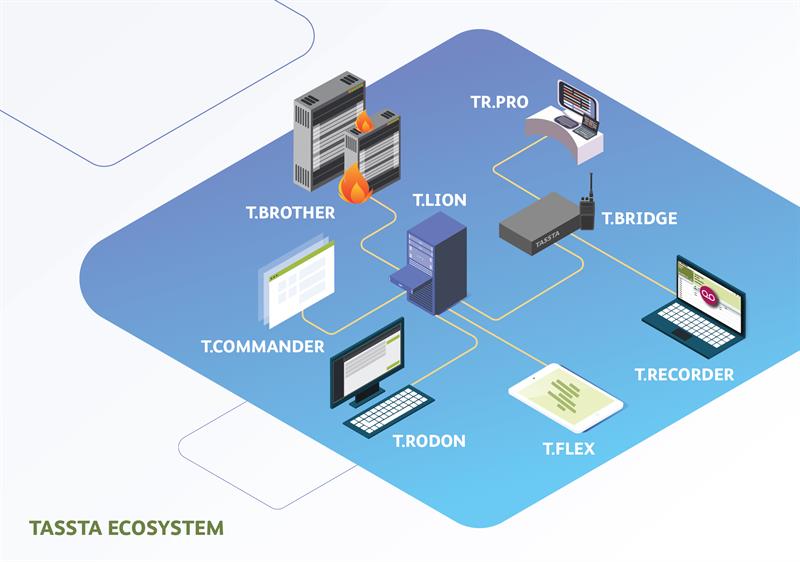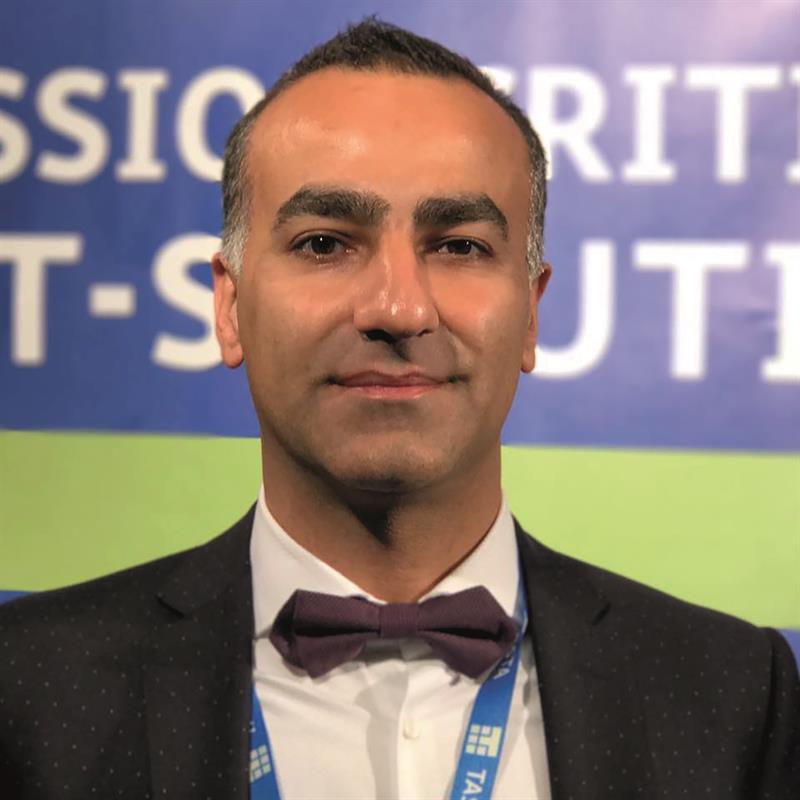If you’re constantly looking to get the most from an (often significant) investment in a radio system, one of the most frustrating things can be spotting a feature from another vendor that would be great for your business that isn’t supported by your existing equipment. It’s also irritating when you find out that a different radio technology would better suit the needs of a particular group of users but both vendors can’t provide the technology to allow that system to interoperate with your current set-up.
Both issues can be resolved through the use of radio gateways and Kaveh Hosseinzadeh, TASSTA’s managing director, says that his company is “perhaps the only company that is focusing so much on a gateway to multiple vendors. We have our gateways to Hytera DMR Tier II (with Tier III is now in preparation), MOTOTRBO, DAMM, Kenwood (conventional, NXDN and DMR) and Sepura.”
“If you work with TASSTA you are independent, you don’t have to stay with one hardware vendor forever – you can always choose. It’s our mission to ensure that users can always obtain the best solution to their requirements.”
Because TASSTA is always working to improve its gateways and increase its support for multiple vendors, Hosseinzadeh adds that this means that users investing in one of its gateways can retain the value of their investment even if they decide to replace their existing radio system with a more modern one.
TASSTA listens extensively to its customers and does a lot of customisation on their behalf. For example, Hosseinzadeh says that it developed Windows CE 5, 6, and 7 clients for a bus operator that needed PTT over Cellular to work on very low powered hardware. This dialogue with its customers is also where much of the inspiration for TASSTA’s features comes from – “We get many of the best ideas from our customers, as they have an intimate knowledge of their own operations and are best placed to know where improvements can be made,” he adds.
Speaking of features, TASSTA offers much more than just gateways. For example, it can provide customers with PTT over Cellular functionality through its T.Flex application, dispatchers (both complex and simple) and voice/GPS recording if required.
“…We have all our solutions on a single platform and we offer them as micro-services. That means if a customer just needs a single solution, he can use it without having to pay for the others,” Hosseinzadeh says.

TASSTA developed and launched a lone worker system (which complies to the German BGR139 labour protection standard) last year and is already “selling it to big customers” and through its relationship with Vodafone Germany. The system includes man down functionality, movement sensors, disconnected/connected device monitoring and the use of the device’s camera and microphone to provide users with more situational awareness of the employee’s environment. There is a complete feature list which can be requested.
Related to this is TASSTA’s indoor localisation solution, which works over Wi-Fi and Bluetooth to an accuracy of +/- three metres, allowing a company with employees split across multiple floors in a high-rise tower block to quickly locate them in the event of an emergency.
In addition to lone worker protection, TASSTA spent much of 2017 improving its gateways and dispatching applications. Hosseinzadeh adds that its T.RODON dispatcher has a number of features of value to security companies, such as route control, task management and geofencing. Combined, these allow security companies to set routes, have proof that patrols took place and quickly raise accurate invoices. Last year, TASSTA also launched its streamlined and minimalist TR.PRO dispatcher designed for users who don’t require a complex dispatch solution for their radio solution(see October’s Land Mobile for more details). TASSTA’s TR.Pro supports all the major two-way radio vendors such as Kenwood, Hytera, Sepura and Motorola Solutions.
Taking aim at AI
Moving from the recent past to the future, in early February TASSTA will introduce the ability for its customers and all users to be able to perform PTT group calls on their WiFi networks, without the need for a TASSTA server. Your smartphone, the TASSTA application and WiFi will be all you need to operate without any registration. “You’ll just have to download the application, type in the channel name and username and then you’ll be able to make PTT calls for free to other users on the same WiFi network and channel,” Hosseinzadeh says. “We will provide a basic tutorial in the form of a YouTube video that will cover the app’s features.”
“In 2018 and over the next few years we will increase our use of artificial intelligence. We are going to use it to give decision makers the information they need to make the best decisions.” This year, TASSTA is also planning to implement some video functionality and this will include facial recognition. “Right from the start of an incident, our system will be gathering information to aid decision making,” he adds.
“Our devices use all the information possible whenever any incident is happening. We’ll even be using sensors to monitor a user’s behaviour. If it substantially deviates from his usual routine, we can start to record his movements and calls, allowing us to provide information related to an incident before it even begins.“
Looking ahead to MCPTT
As part of its commitment to offering the best possible PTT over Cellular solution to its customers, TASSTA participated in the MCPTT (Mission Critical Push to Talk) plugtest held by ETSI back in June and is looking to attend similar events in the future. The plugtest was held with the aim of ensuring interoperability between vendors when it comes to implementing the MCPTT features specified in 3GPP Release 13 (and the improvements being introduced in Releases 14 and 15), through connecting different parts of the system (supplied by different vendors) together and then testing their performance.
“We were one of the few companies worldwide who provided a MCPTT server and client and could show the interoperability between our solution and the solutions from the other companies that participated. For this year’s plugtest, we’re also planning to bring our own IP Multimedia Subsystem (IMS),” Hosseinzadeh says, adding that this is a “huge achievement” given the complex nature of the MCPTT standard.
While Hosseinzadeh notes that the vendor certification process for MCPTT has yet to be implemented, he says that TASSTA’s current MCPTT solution is 3GPP Release 13 and Release 14 compliant, allowing end users to take full advantage of MCPTT while using the hardware and end user devices of their choice.
Become a TASSTA partner
The past five years have been one of explosive growth for Germany-based TASSTA and its products and solutions are now being used by the German Army, along with household names such as Volkswagen, BASF, Bayer and Daimler. “We’ve reached the stage where we have a lot of huge and trusted organisations as customers. During the last year, we saw a four-fold increase in our [worldwide] user base compared to the end of 2016.”
TASSTA saw its sales revenue triple in 2016 and while the final numbers aren’t in for 2017, Hosseinzadeh expects to be able to report around 60 per cent sales growth year on year for last year. He attributes much of this growth to TASSTA’s partners around the world (it only does direct sales in Germany, its home market). These “are deploying projects using our solutions on a daily basis for their own customers and end-users”.
It might therefore not come as a surprise to learn that TASSTA is “always looking for more partners. We currently have around 20 partners worldwide and in the next few weeks, that should rise to 25-30.”
“Their local knowledge of regional requirements, the end-users, the culture and the language of the country in which they’re based helps us stay two steps ahead of our competitors. Without our partners, we couldn’t have got to where we are today.”
Why partner with TASSTA? Hosseinzadeh points to its impressive growth and firmly believes that through partnering with his company, dealers and distributors can substantially boost their own sales, given the new sales opportunities TASSTA’s solution create. “They can sell to existing customers who haven’t been active in the market for years, by bringing them dispatchers, PTT-enabled smartphones and introducing new high value features that the customer has never seen before. They can also better meet the needs of customers who come to them saying ‘you sold us a radio solution, do you have any idea how to improve it this year?’.”
He continues: “Besides offering our partners one of the most innovative solutions for PTT worldwide, our solutions don’t need much maintenance and our partners’ engineers can support their customers with just one week’s training.”
Hosseinzadeh adds that TASSTA will soon be visiting Japan and Malaysia to extend its global reach and last year implemented its first system in the Philippines with the help of a local partner.
Out and about
While we’re on the subject of travel, if you’re interested in what TASSTA has to offer and would like to know more about it first hand, you can find Hosseinzadeh and his colleagues at many of the big PMR events, along with those that support PMR’s biggest vertical markets.
For example: “We are going to InterSec in Dubai, while on the PMR side we will have quite a strong presence at CCW Berlin in May and PMRExpo. We’re especially looking forward to CCW as it is being held in our home country. Last year we attended Comms Connect in Australia and PMRExpo in Germany.”
Summing up, Hosseinzadeh says: “We at TASSTA understand PMR well because our heart and origins are in radio and we’re using that expertise to take PTT over Cellular to the next stage with MCPTT [see boxout]. We understand the needs of PMR users, and particularly the requirements for mission critical, robust solutions capable of working in rough conditions with low latency. We’re able to support customers with voice-recording, location-tracking, and alarming. These features and requirements are not understood by a typical telecom company.”

Kaveh Hosseinzadeh, TASSTA’s managing director
Contact Information:
For more information, please email TASSTA at: kh@TASSTA.com



